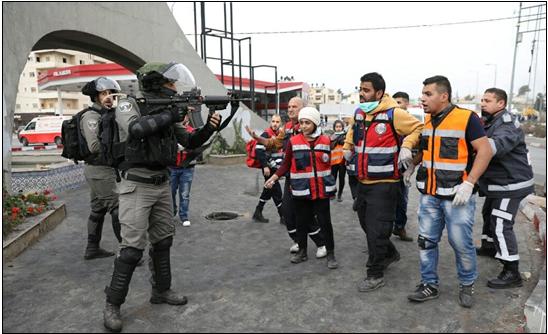In December 2017, between the 7th and 31st of the month, Israeli forces shot and killed 10 Palestinians and wounded another 408 during protests against US President Donald Trump’s declaration recognizing Jerusalem as the capital of Israel.
Eight of the dead were unarmed Palestinians demonstrating near the Gaza perimeter fence, none of whom posed a mortal danger to the soldiers involved. On December 8, a soldier shot Mahmoud ‘Abd al-Majid Salem al-Masri (29) in the thigh. Al-Masri, who died from his wound, was 20 to 30 meters from the fence, throwing stones at soldiers on the other side. On the same day, a soldier shot Muhammad Sami Hashem a-Dahdouh (19) in the neck during a demonstration near Nahal Oz Checkpoint. A-Dahdouh was 10 to 15 meters from the fence when he was shot, trying to throw stones at soldiers on the other side. He died of his wounds on December 24.

An Israeli Border Policeman threatens Palestinian medics and journalists with point blank death during a protest at the Beit El junction, occupied West Bank, December 22, 2017. (Photo: Activestills)
On December 15, a soldier fatally shot Ibrahim Nayef Ibrahim Abu Thuraya (29) in the head during a demonstration near the Nahal Oz Checkpoint. Abu Thuraya was some 15 to 20 meters from the fence when he was shot. During the same demonstration in which Abu Thuraya was killed, a soldier fatally shot Yasser Naji Ibrahim Sukar (23) in the head.
On December 17, a soldier shot Sharif al-‘Abed Muhammad Shalash (28) in the abdomen during a demonstration east of Jabalya Refugee Camp. Shalash died of his wounds on December 23.
On December 22, a soldier fatally shot Zakaria Adham Hussein al-Kafarneh (20) in the chest during a demonstration near the Erez Checkpoint. Al-Kafarneh was trying to cut barbed wire that was laid across the ground some 50 meters from the fence. Soldiers then fired teargas at the young men who were carrying the wounded al-Kafarneh to an ambulance waiting some 300 meters from the fence. That same day, a soldier shot Muhammad Nabil Muhammad Muheissen (29) in the thigh during a demonstration near Nahal Oz Checkpoint. Muheissen died from his wound. During that protest, demonstrators threw stones at soldiers located on the other side of the fence.
On December 29, a soldier shot Jamal Muhammad Jamal Muslah (20) in the back during a demonstration. Muslah had been throwing stones at soldiers on the other side of the fence. He was shot after he hung a Palestinian flag on the fence and was moving away from the barrier. He died of his wounds on December 30.
Two of December’s fatalities were in the West Bank, soldiers fatally shot Basel Mustafa Muhammad Ibrahim (29) in the abdomen during clashes at ‘Anata, and Border Police shot and killed Muhammad Amin Mahmoud Shehadeh ‘Aqel (19) during clashes at City Square in al-Birah, after he stabbed a Border Police officer. According to media reports, the officer sustained moderate injuries. ‘Aqel was wearing a mock explosive device, and in footage aired by the media, officers are seen firing at him as he lay on the ground.
In addition to the above 10 fatalities, hundreds of Palestinians have been injured by live ammunition fired during the demonstrations since Trump’s December 6 declaration. According to Red Crescent figures, from December 7 to 31, Israeli security forces fired live ammunition that injured 291 Palestinians in Gaza and 117 in the West Bank, at total of 408 injuries by live fire during three and a half weeks.
B’Tselem – The Israeli Information Center for Human Rights in the Occupied Territories – has written: “The utter indifference with which this high number of casualties and wounded has been met in Israel begs a reminder of what should be obvious: Live gunfire is permitted only as a last resort, in cases of imminent mortal danger that cannot be averted by any other means. In the Gaza demonstrations described above, the soldiers were located on the Israeli side of the fence, at some distance from the Palestinian protesters. They were undeniably not in mortal danger – certainly not of a kind that could not be prevented by other means.”
“Yet even this recent upsurge in the killing and injury of Palestinians through the unlawful and excessive use of live ammunition will not, most probably, be addressed any differently than thousands of other cases in which no one was held accountable. The announcement of the launching of an investigation by the Military Police Investigation Unit into the killing of Ibrahim Abu Thuraya – released after the incident sparked headlines in Israel and around the world – holds no promise. It is no more than the first in a routine series of steps taken to whitewash the circumstances in which Israeli security forces kill Palestinians.”


